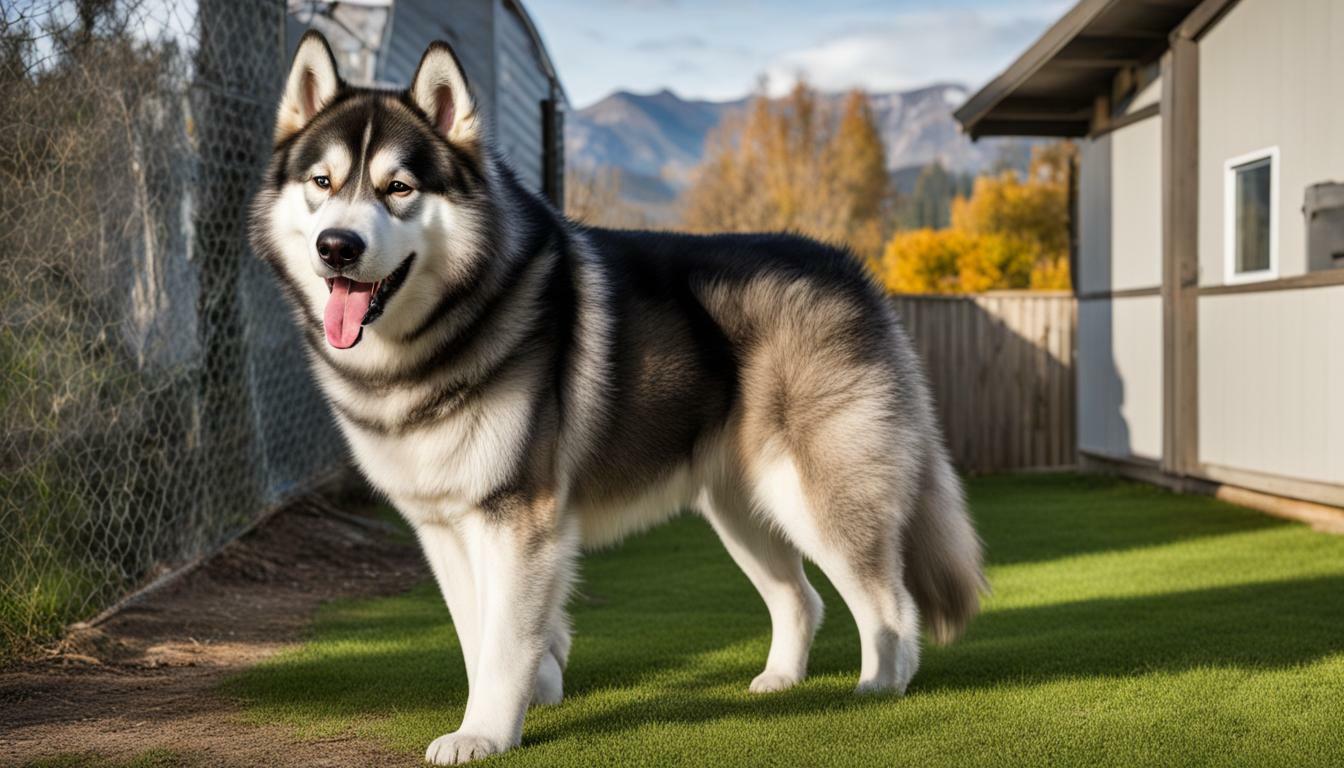Alaskan Malamutes are known for their unique vocalizations and communication style. They are not frequent barkers like some other breeds, but they have their own way of making noise. Instead of barking, Malamutes are more likely to “woo,” howl, and talk back to their owners. These expressive vocalizations are a natural part of their communication.
While the amount of barking can vary between individual dogs, it is important to note that Alaskan Malamutes are considered to be a noisy breed by nature. They may bark occasionally to alert their household to potential threats or simply to get their owner’s attention. However, it is their distinctive “wooing” sound that is often associated with this breed. Wooing is a drawn-out vocalization that can be quite melodic and expressive.
In addition to wooing, Malamutes can also make other noises like growling and grumbling. These sounds are part of their unique way of communicating with their owners and other dogs. It is important to understand that trying to stop a Malamute from barking or wooing completely may not be realistic or even desirable, as it is an innate part of their communication.
However, there are strategies to help calm a Malamute down in stressful situations and prevent excessive barking. Providing them with plenty of exercise and mental stimulation is key to keeping them happy and content. Malamutes are an active breed that requires a lot of attention and physical activity to prevent destructive behaviors.
It is also important to consider the compatibility of Alaskan Malamutes with families and other pets. They may not be the best choice for households with small children or smaller pets, as their energetic nature and potential barking tendencies may not align well with these dynamics.
Lastly, health considerations should not be overlooked when considering Alaskan Malamutes. They can be prone to certain health issues, such as hip dysplasia and hypothyroidism. It is crucial to get a Malamute from a reputable breeder who prioritizes health screening and responsible breeding.
To sum up, Alaskan Malamutes are energetic and expressive companions that require a lot of attention, exercise, and mental stimulation. Their unique vocalizations and communication style make them a fascinating breed to interact with. Understanding and embracing their natural tendencies can lead to a fulfilling and harmonious relationship with these beautiful dogs.
Alaskan Malamutes: A Noisy Breed by Nature
Despite not being frequent barkers, Alaskan Malamutes are known for their vocal nature. Instead of traditional barking, these majestic dogs are more likely to “woo,” howl, and talk back to their owners. They have a unique way of expressing themselves through various vocalizations that can be quite melodious. While their barking frequency may not be high, their overall noise level can be quite significant.
Alaskan Malamutes may occasionally bark to alert their household to potential threats, but their primary form of communication is through their distinctive “woo” sound. This drawn-out vocalization is often used to express excitement, frustration, or a desire for attention. Additionally, they can make other noises like growling and grumbling, which adds to their vocal repertoire.
It is essential to understand that trying to completely stop an Alaskan Malamute from barking or “wooing” is an unrealistic goal. These vocalizations are deeply ingrained in their nature and serve as a means of communication. However, you can employ calming techniques to minimize excessive vocalizations, especially in stressful situations.
Quote:
“Alaskan Malamutes have a unique way of communicating through vocalizations. Their melodic ‘woo’ sound and other noises they make add to their charm and make them a truly unique breed.” – Alaskan Malamute enthusiast
Alaskan Malamute Care and Exercise Needs
| Care Needs | Exercise Requirements |
|---|---|
| Alaskan Malamutes have a thick double coat that requires daily brushing to keep it in good condition. | Malamutes are active dogs and require plenty of exercise to prevent destructive behaviors. They thrive in households that can provide them with ample physical activity, such as long walks, runs, or activities like sled pulling. |
| Regular grooming, including nail trimming and ear cleaning, is essential to maintain their overall health and hygiene. | Engaging them in mental stimulation activities, such as puzzle toys or obedience training, also helps keep these intelligent dogs stimulated and content. |
It’s important to note that Alaskan Malamutes are not the best breed for families with small children or households with smaller pets. Their energetic nature, combined with their vocal tendencies, may be overwhelming for these situations. Additionally, they are a large and robust breed, so proper socialization and training are essential from an early age.

Health-wise, Alaskan Malamutes can be susceptible to certain conditions like hip dysplasia and hypothyroidism. To ensure their well-being, it’s crucial to get them from a reputable breeder who conducts health screenings and follows responsible breeding practices.
In conclusion, Alaskan Malamutes are lively, vocal companions that require an active lifestyle and plenty of mental stimulation. While they may not bark frequently, their vocalizations, including their signature “woo” sound, make them a noisy breed by nature. Understanding their communication style and meeting their exercise and socialization needs are key to ensuring a harmonious relationship with these majestic dogs.
Reasons for Alaskan Malamute Barking
Alaskan Malamutes may bark occasionally to communicate various needs or alert their owners. While they are not frequent barkers like some other breeds, they have their own unique ways of vocalizing. Instead of barking, Malamutes are more likely to “woo,” howl, and talk back to their owners. This vocalization is a natural part of their communication and can serve different purposes.
One reason why Alaskan Malamutes may bark is to express excitement or happiness. When they see their owners after being apart or when they are anticipating something fun, they may let out a series of enthusiastic barks or wooing sounds. This is their way of showing their joy and eagerness.
Another reason for Alaskan Malamute barking is to alert their household to potential threats or unusual occurrences. They have a strong protective instinct and will bark to let their owners know if they sense something out of the ordinary. This can include strangers approaching the house, unfamiliar sounds, or any perceived danger.
It’s important to note that the amount of barking can vary between individual dogs. Factors such as personality, training, and the environment they are raised in can influence their barking habits. If a Malamute is raised in a household with other frequent barkers, they may learn to bark more frequently as well.
Understanding Alaskan Malamute Vocalizations
Alaskan Malamutes are known for their signature “woo” sound, which is a long, drawn-out vocalization. This sound is different from the typical bark and is often accompanied by a stretching or upward movement of the head and neck. The “woo” can serve different purposes, such as expressing happiness, seeking attention, or even communicating distress.
In addition to the “woo,” Alaskan Malamutes can make other noises like growling and grumbling. These sounds are part of their vocal repertoire and can be used to express various emotions or needs. For example, a low growl may indicate that they are feeling threatened or uncomfortable, while a playful grumble may be a sign of excitement during playtime.
It’s important to understand and appreciate these vocalizations as part of the Alaskan Malamute’s nature. While it may be difficult to completely stop a Malamute from barking or wooing, it is possible to calm them down in stressful situations through positive reinforcement and training techniques. Providing them with plenty of exercise and mental stimulation can also help keep them content and prevent excessive barking.
Alaskan Malamute Vocalizations
Alaskan Malamutes are not known for being frequent barkers, but they have their own unique ways of vocalizing. Instead of barking, they are more likely to “woo,” howl, and talk back to their owners. This vocalization is a natural part of their communication and can serve different purposes.
The signature sound of an Alaskan Malamute is the “woo” which is a long, drawn-out vocalization. This sound can vary in tone and intensity, and it is often accompanied by a stretching or upward movement of the head and neck. Alaskan Malamutes may use the “woo” to express happiness, seek attention, or even communicate distress.
In addition to the “woo,” Alaskan Malamutes can make other noises like growling and grumbling. These sounds are part of their vocal repertoire and can be used to express various emotions or needs. For example, a low growl may indicate that they are feeling threatened or uncomfortable, while a playful grumble may be a sign of excitement during playtime.
It is important to understand and appreciate these vocalizations as part of the Alaskan Malamute’s nature. While it may be difficult to completely stop a Malamute from barking or wooing, it is possible to calm them down in stressful situations through positive reinforcement and training techniques. Providing them with plenty of exercise and mental stimulation can also help keep them content and prevent excessive barking.
Factors Affecting Alaskan Malamute Barking
Various factors, such as behavior and environment, can impact the amount of barking displayed by Alaskan Malamutes. Understanding these factors can help owners manage and address excessive barking in their beloved pets. Alaskan Malamutes are known for their strong personalities and independent nature, which can contribute to their barking tendencies.
In terms of behavior, the socialization and training that Alaskan Malamutes receive play a significant role. Proper socialization from a young age can help reduce anxiety and fear, which are common triggers for excessive barking. Positive reinforcement training methods can also aid in teaching Alaskan Malamutes appropriate behaviors and communication techniques.
The environment in which an Alaskan Malamute resides can also influence their barking habits. For instance, if a Malamute is regularly exposed to loud sounds or frequent barking from other dogs in their surroundings, they may be more inclined to vocalize in response. Similarly, if they are kept in isolation for long periods without sufficient mental and physical stimulation, they may resort to barking out of boredom or frustration.
To minimize excessive barking, it is essential to provide Alaskan Malamutes with adequate exercise and mental stimulation. These energetic dogs require regular physical activity to channel their energy and prevent boredom-related barking. Engaging them in interactive play, such as fetching or puzzle toys, can also keep them mentally stimulated. Additionally, creating a calm and secure environment for an Alaskan Malamute, free from excessive noise or stressors, can help curb their barking tendencies.
Table: Factors Affecting Alaskan Malamute Barking
| Factor | Description |
|---|---|
| Behavior | Personality traits, socialization, and training |
| Environment | Noise levels, presence of frequent barkers, and mental stimulation |
| Exercise | Amount and frequency of physical activity |
It is important to note that while barking is a natural form of communication for Alaskan Malamutes, excessive and continuous barking may indicate underlying behavioral issues or discomfort. If a Malamute’s barking becomes uncontrollable or seems abnormal, consulting with a professional dog trainer or veterinarian is recommended to address any potential concerns.

Alaskan Malamutes have a unique vocalization style, including the famous “woo” sound and other noises like growling and grumbling. Instead of traditional barking, Malamutes are more likely to “woo” in a high-pitched, melodic manner. This distinctive vocalization is deeply ingrained in their nature and serves as a means of communication, expressing various emotions and needs. The “woo” sound can range from a soft, gentle howl to a loud, enthusiastic bark-like noise that can be heard from a distance.
The “woo” is not the only sound Malamutes make. They also exhibit growling and grumbling noises, especially during play or when expressing frustration or displeasure. These sounds are part of their expressive repertoire and can vary in intensity depending on the situation. It is fascinating to witness the range of vocalizations that Alaskan Malamutes can produce, showcasing their unique personalities and strong communication skills.
“Alaskan Malamutes are known for their signature ‘woo’ sound, which can be both enchanting and amusing. It’s their way of voicing their thoughts and emotions, whether it’s excitement, loneliness, or a desire to communicate with their human companions.” – Alaskan Malamute expert
The Importance of Understanding Alaskan Malamute Vocalizations
Understanding the vocalizations of Alaskan Malamutes is crucial for their owners to foster strong bonds and effective communication. By recognizing the different sounds and their meanings, you can better respond to your Malamute’s needs and ensure their well-being. The “woo” sound, for example, can indicate anything from boredom to loneliness or the desire to engage in activities together. By paying attention to their vocalizations, you can better understand what your furry companion is trying to convey and build a deeper connection.
It’s important to note that while Alaskan Malamutes may be more vocal than other breeds, excessive barking can be a sign of underlying issues such as anxiety or boredom. If your Malamute’s vocalizations become excessive or persistent, it is essential to address any potential underlying causes and seek professional guidance to ensure their emotional and mental well-being.
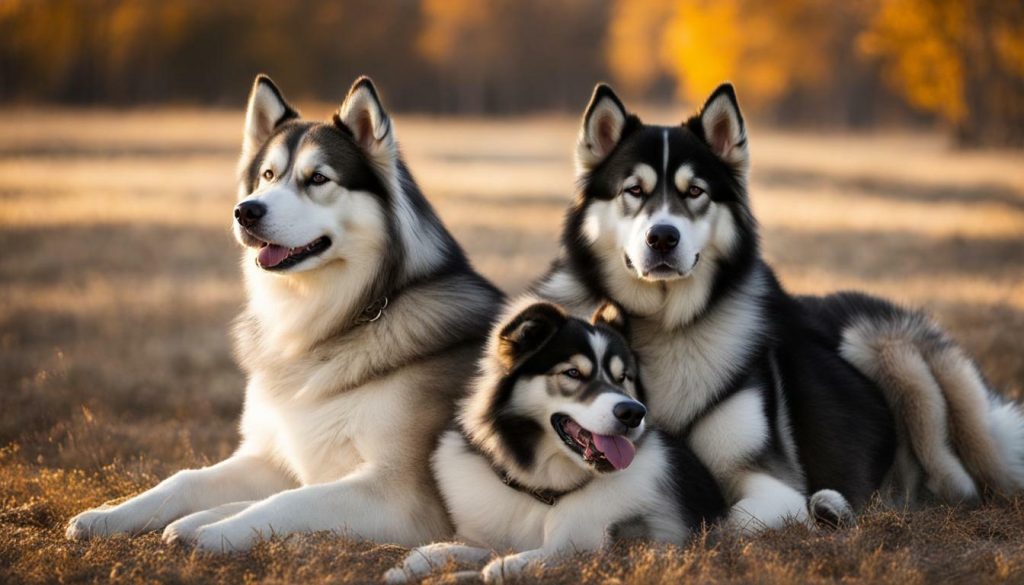
In conclusion, Alaskan Malamutes have a unique vocalization style, with the famous “woo” sound being a prominent characteristic. Alongside growling and grumbling, these vocalizations serve as a way for Malamutes to express their emotions and communicate with their owners. Understanding and interpreting their vocalizations can enhance the bond between you and your furry companion, allowing for better communication and a happier, more harmonious relationship.
Controlling Alaskan Malamute Barking
While it is difficult to completely stop an Alaskan Malamute from barking, there are methods to control and minimize their barking behavior. Understanding the underlying reasons behind their vocalizations can help you address the issue effectively. One of the main reasons Alaskan Malamutes bark is to communicate, either to get your attention or to alert you to potential threats. By providing them with proper training and socialization, you can teach them when it is appropriate to bark and when it is not.
Positive reinforcement techniques can be highly effective in controlling Alaskan Malamute barking. Rewarding your Malamute with treats, praise, or playtime when they remain calm during situations that typically trigger barking can help reinforce the desired behavior. It is important to be consistent and patient with the training process, as it may take time for your Malamute to learn the appropriate responses.
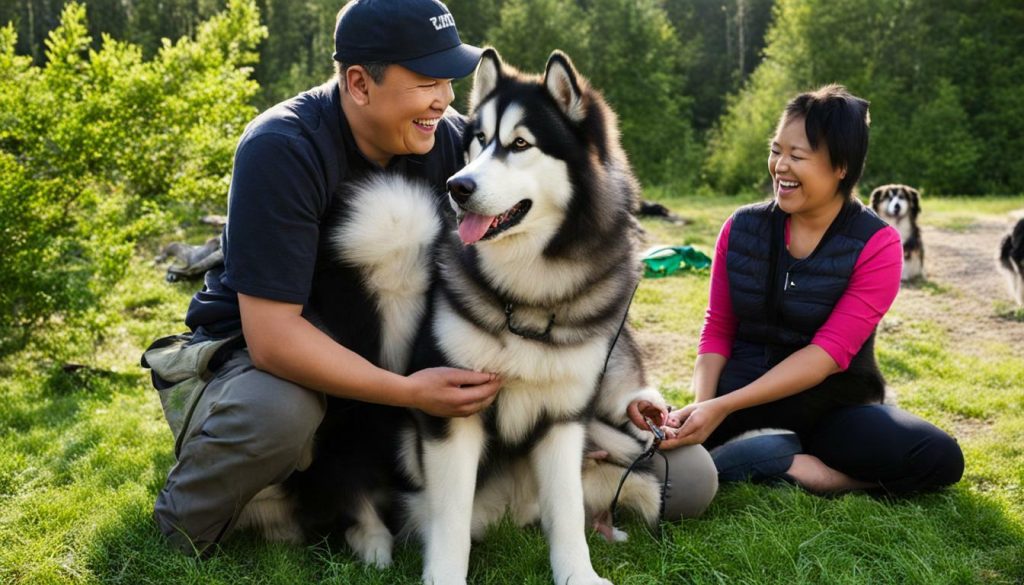
Another helpful strategy is providing your Alaskan Malamute with plenty of exercise and mental stimulation. Daily walks, playtime, and interactive toys can help tire them out physically and mentally, reducing their overall energy and likelihood of excessive barking. A tired Malamute is a content Malamute, less prone to barking out of boredom or frustration.
Additionally, creating a calm and peaceful environment for your Alaskan Malamute can also contribute to minimizing their barking. Removing triggers such as loud noises or other dogs barking excessively in the vicinity can help keep your Malamute calm and less likely to join in. Providing them with a designated space where they feel secure and comfortable can also help reduce anxiety-related barking.
Summary
Controlling and minimizing Alaskan Malamute barking requires understanding their communication needs, providing positive reinforcement training, ensuring adequate exercise and mental stimulation, and creating a calm environment. While it may not be possible to completely eliminate their barking, these strategies can help you manage and minimize it effectively. By investing time and effort into training and meeting their needs, you can enjoy a harmonious relationship with your Alaskan Malamute and create a peaceful living environment for both you and your furry companion.
Alaskan Malamute Care and Exercise Needs
Providing adequate exercise and mental stimulation is crucial in managing Alaskan Malamute behavior, including their barking tendencies. These energetic dogs require regular physical activity to prevent boredom and subsequent destructive behaviors. Daily walks, runs, or engaging in activities such as hiking or sledding can help keep them content and reduce excessive barking.
Additionally, mental stimulation is important for Alaskan Malamutes. They are intelligent and need mental challenges to keep their minds occupied. Interactive toys, puzzle games, and obedience training sessions can all provide the mental stimulation they need and help minimize barking due to boredom or frustration.
Malamutes also have a thick double coat that requires regular grooming. Daily brushing is necessary to keep their coat in good condition and prevent matting. Regular grooming sessions also offer an opportunity to bond with your Malamute and provide them with positive reinforcement, which is essential in their training and behavior management.
| Exercise needs: | Grooming needs: |
|---|---|
| High exercise needs | Regular brushing |
| Long walks, runs, or engaging activities | Daily grooming to prevent matting |
| Mental stimulation through interactive toys and training | Opportunity for bonding and positive reinforcement during grooming |
Alaskan Malamutes require a lot of attention and exercise, making them best suited for active households. The breed is not recommended for families with small children or households with smaller pets due to their energetic nature and potential barking tendencies. It is crucial to meet their exercise and mental stimulation needs to prevent excessive barking and keep them happy and content.
Health Considerations for Alaskan Malamutes
It is important to note that Alaskan Malamutes can be prone to certain health issues, such as hip dysplasia and hypothyroidism. To ensure the health and well-being of your Malamute, it is essential to obtain them from a reputable breeder who performs proper health screenings on their breeding stock. Regular veterinary check-ups and maintaining a healthy diet are also crucial in preventing and managing potential health problems that could contribute to excessive barking or discomfort.
By providing the necessary care, exercise, and mental stimulation, you can create a harmonious environment for your Alaskan Malamute and minimize their barking tendencies. Understanding their specific needs and taking proactive measures will help you build a strong bond with your furry friend and ensure their overall well-being. With the right approach, Alaskan Malamutes can be active companions that bring joy and happiness to your household.
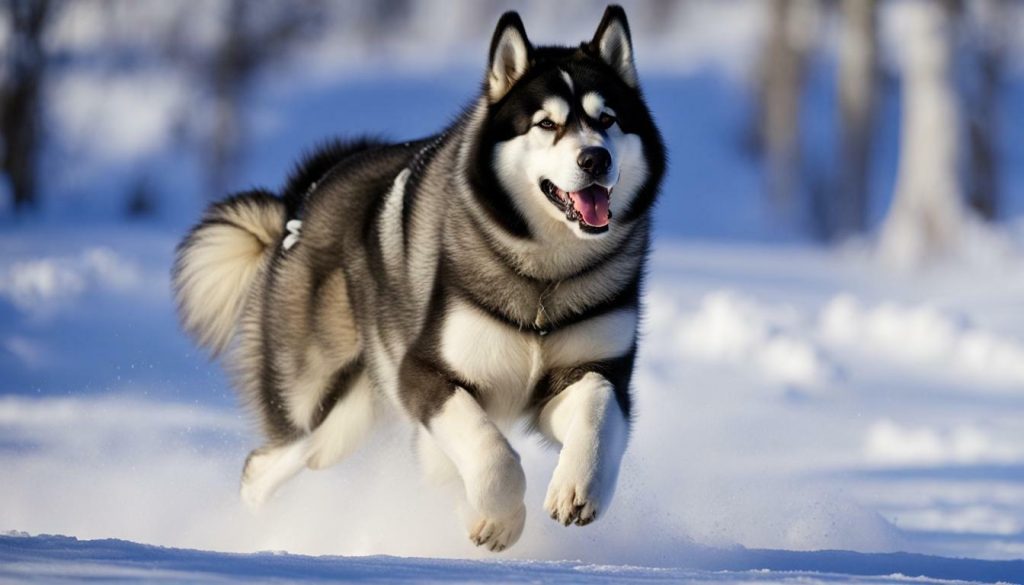
Alaskan Malamutes may not be the best fit for families with small children or households with smaller pets due to their energy levels and vocal nature. These majestic dogs are renowned for their strength, endurance, and independent spirit, which can sometimes make them a challenging choice for households with young children. Their exuberant energy and size may pose a risk of unintentional knocks or knocks, especially to smaller children. Additionally, their vocal nature, although not excessive barking, can be overwhelming for households looking for a quieter pet.
However, with proper training, socialization, and supervision, Alaskan Malamutes can still be wonderful companions in the right circumstances. Older children who can handle their energetic nature and understand how to interact respectfully with dogs may find joy in the playful and affectionate personality of a Malamute. Supervision is key to ensure the safety and well-being of both the child and the dog.
When it comes to smaller pets such as cats, rabbits, or small dogs, it’s important to consider the prey drive of Alaskan Malamutes. Due to their heritage as sled dogs, which involved working alongside other animals, Malamutes have a strong instinct to chase small creatures. It’s recommended to introduce them to smaller pets gradually and under controlled conditions to assess their compatibility. Providing proper socialization from an early age and positive reinforcement training can help mitigate any potential issues.
| Pros | Cons |
|---|---|
| Strong, loyal, and affectionate | High energy and exercise needs |
| Great for active families | Potential challenges with small children |
| Beautiful and striking appearance | May not get along with smaller pets |
| Intelligent and trainable | Requires regular grooming |
Alaskan Malamutes are lively and gregarious dogs that thrive in energetic households where they can receive ample exercise and mental stimulation. Their endearing personalities and stunning looks make them a popular breed, but it’s crucial to consider their compatibility with your specific family dynamics and existing pets. Proper research, preparation, and commitment are key to ensuring a successful and harmonious relationship with an Alaskan Malamute.
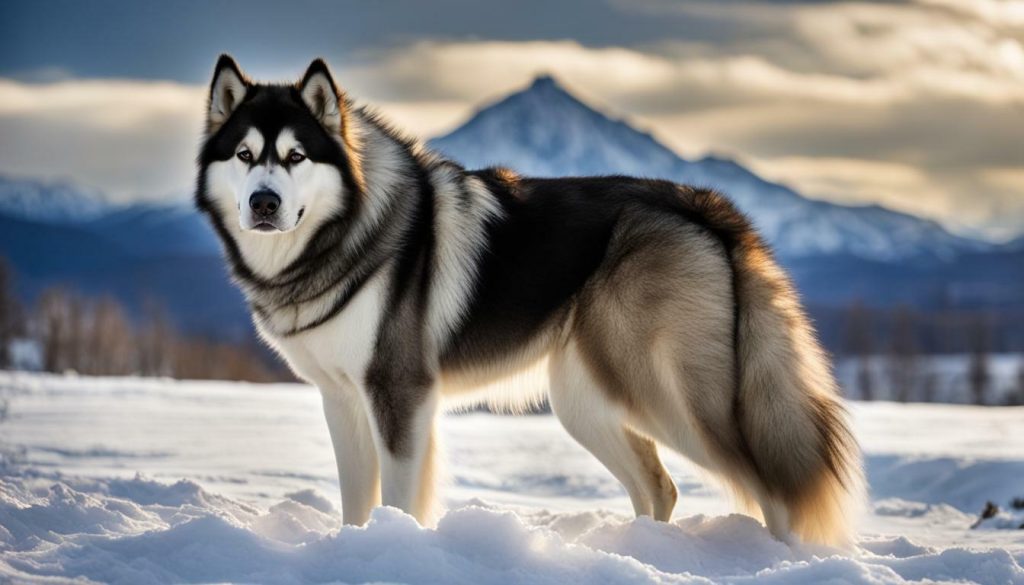
Remember, every dog is an individual, and while some Alaskan Malamutes may thrive in families with small children or coexist peacefully with smaller pets, it’s essential to assess the unique needs and temperament of each dog. Consulting with a reputable breeder, experienced trainer, or animal behaviorist can provide valuable insights and guidance regarding the compatibility of an Alaskan Malamute with your specific circumstances.
Health Considerations for Alaskan Malamutes
Alaskan Malamutes can be susceptible to certain health conditions, making it essential to obtain them from reputable breeders and prioritize proper health screening. These large and active dogs are known to be generally healthy, but like many breeds, they have a predisposition to specific health issues that potential owners should be aware of.
One common health concern for Alaskan Malamutes is hip dysplasia, a genetic condition that affects the hip joint and can lead to pain, lameness, and arthritis. Regular exercise and maintaining a healthy weight can help mitigate the effects of this condition, but responsible breeding practices that include hip evaluations of breeding dogs are crucial in minimizing the incidence of hip dysplasia in the breed.
Hypothyroidism is another health condition that Alaskan Malamutes may be prone to. This condition occurs when the thyroid gland does not produce sufficient thyroid hormone, leading to symptoms such as weight gain, lethargy, and skin problems. Regular screening and appropriate treatment can help manage hypothyroidism, ensuring the overall well-being of the dog.
Health Considerations for Alaskan Malamutes: A Summary
Alaskan Malamutes are generally healthy dogs, but they can be predisposed to certain health conditions. Responsible breeding practices and proper health screening are crucial in maintaining the health of the breed. Common health concerns include hip dysplasia and hypothyroidism. Regular exercise, weight management, and routine veterinary care are important for keeping Alaskan Malamutes happy and healthy companions.
| Health Condition | Description |
|---|---|
| Hip Dysplasia | A genetic condition affecting the hip joint, causing pain and arthritis. |
| Hypothyroidism | A condition characterized by insufficient production of thyroid hormone, leading to weight gain and skin problems. |
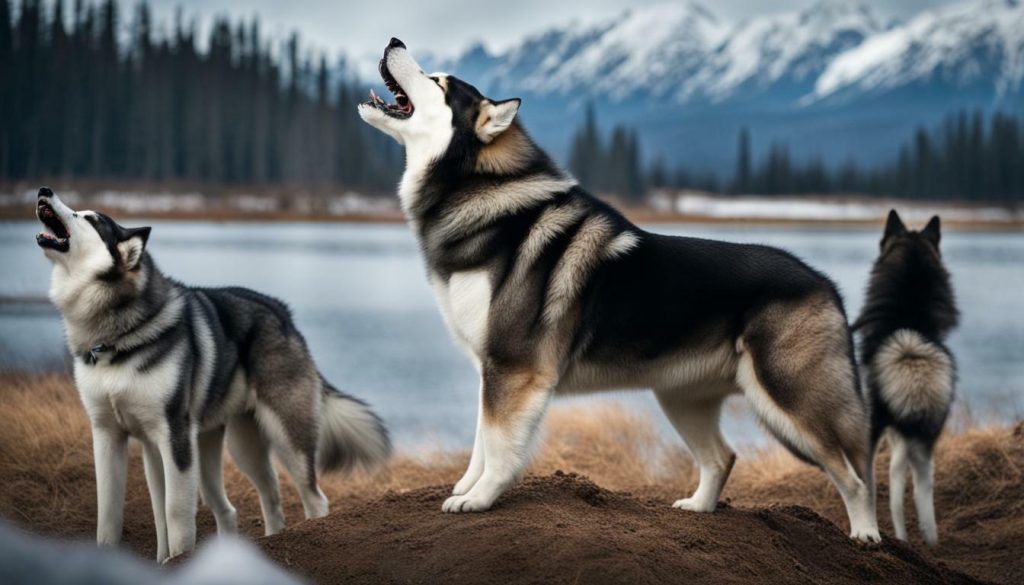
Remember, if you’re considering adding an Alaskan Malamute to your family, it’s essential to work with a reputable breeder who prioritizes the health and well-being of their dogs. Regular veterinary check-ups, a balanced diet, and an active lifestyle will help ensure that your Alaskan Malamute lives a long, happy, and healthy life.
Conclusion: Alaskan Malamutes as Active Companions
Alaskan Malamutes are energetic and vocal companions, requiring dedicated care and exercise to thrive in active households. While they may not be frequent barkers, they are a noisy breed by nature. Instead of barking, they are more likely to “woo,” howl, and talk back to their owners. Occasional barking may occur to alert their household to potential threats.
The amount of barking can vary between individual dogs, but it is important to note that if a Malamute is raised in a household with other frequent barkers, they may become more vocal themselves. Wooing, a drawn-out vocalization, is a common sound made by Malamutes, along with other noises like growling and grumbling. It is difficult to stop a Malamute from barking or wooing as it is a natural part of their communication, but they can be calmed down in stressful situations with proper training and handling.
To keep a Malamute happy and prevent destructive behaviors, they require a lot of exercise and mental stimulation. Daily walks, interactive playtime, and puzzle toys are essential to meet their needs. Additionally, their thick double coat needs regular brushing to keep it in good condition. It is important to note that Alaskan Malamutes are not the best breed for families with small children or households with smaller pets. Due to their energetic nature and potential barking tendencies, they are better suited for active households where they can receive the attention and exercise they require.
Health-wise, Alaskan Malamutes can be prone to certain conditions such as hip dysplasia and hypothyroidism. To ensure their well-being, it is crucial to obtain a Malamute from a reputable breeder who prioritizes responsible breeding practices and health screening. Regular check-ups with a veterinarian, a balanced diet, and proper grooming are also essential in maintaining their overall health.
In conclusion, Alaskan Malamutes are energetic and vocal companions that bring joy and excitement to active households. Providing them with dedicated care, exercise, and mental stimulation is crucial for their well-being. While their barking habits may be different from other breeds, understanding their unique vocalizations and needs will help create a harmonious and fulfilling relationship with these wonderful dogs.
FAQ
Q: Do Alaskan Malamutes bark a lot?
A: Alaskan Malamutes are not frequent barkers, but they are a noisy breed by nature. Instead of barking, they are more likely to “woo,” howl, and talk back to their owners. They may bark occasionally to alert their household to potential threats.
Q: What other vocalizations do Alaskan Malamutes make?
A: In addition to “wooing,” which is a drawn-out vocalization, Alaskan Malamutes can also make other noises like growling and grumbling.
Q: Can I train my Alaskan Malamute to stop barking or wooing?
A: It is difficult to stop a Malamute from barking or wooing as it is a natural part of their communication. However, it is possible to calm them down in stressful situations and manage their barking through positive reinforcement and training techniques.
Q: Are Alaskan Malamutes good for families with small children or smaller pets?
A: Alaskan Malamutes are not the best breed for families with small children or households with smaller pets. Due to their energetic nature and potential for vocalization, they may not be suitable for households with young children or smaller animals.
Q: What health issues should I be aware of with Alaskan Malamutes?
A: Alaskan Malamutes can be prone to certain health issues, including hip dysplasia and hypothyroidism. It is important to get them from a reputable breeder and ensure proper health screening.
Q: How much exercise do Alaskan Malamutes require?
A: Alaskan Malamutes require a lot of exercise and mental stimulation to keep them happy and prevent destructive behaviors. Daily exercise and playtime are essential for their well-being.
